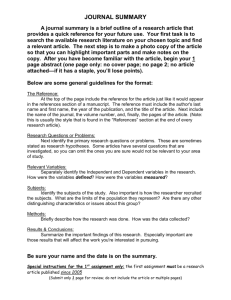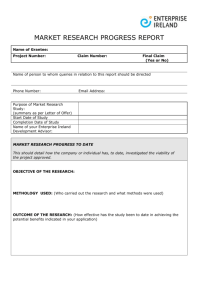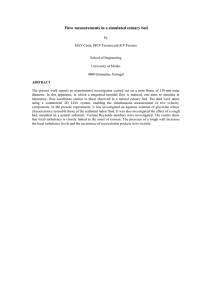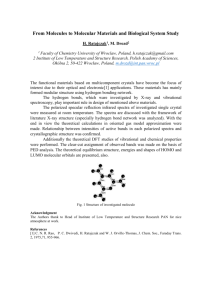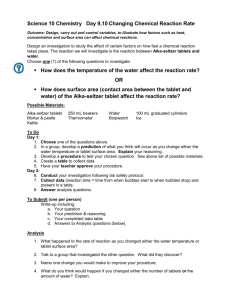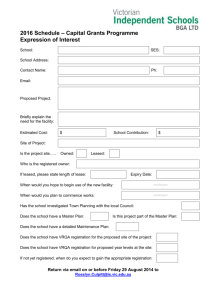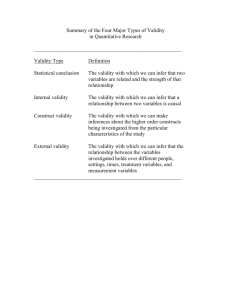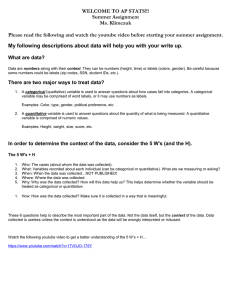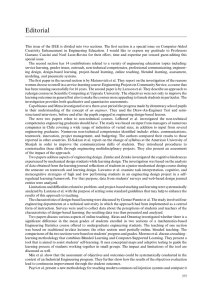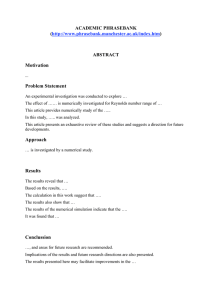experimental design and methods
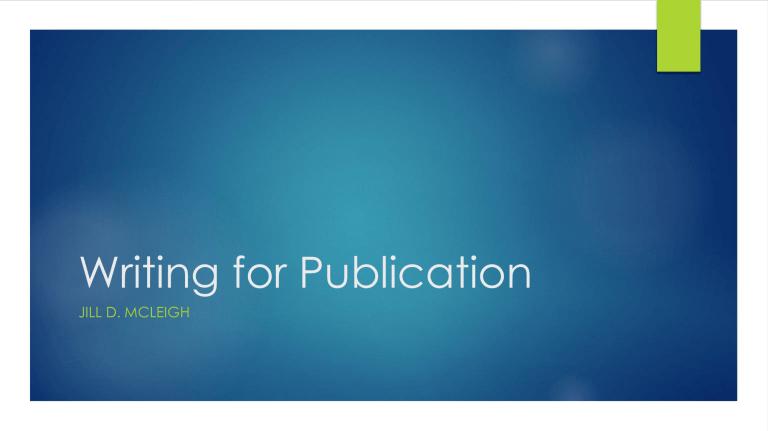
Writing for Publication
JILL D. MCLEIGH
Writing a journal article
Common reasons for rejection
What happens when I submit an article?
Writing a journal article
Experimental process
What did I do in a nutshell?
What is the problem?
Conceptual framework/background
How did I solve the problem?
What did I find out?
What does it mean? What are the implications?
Whose work did I refer to?
Section of Paper
Abstract
Introduction
Literature Review
Materials and Methods
Results
Discussion
References
Word Count
150-250
500-1,000
1,000-2,000
500-1,000
1,000-1,500
1,000-1,500
Abstract
Function: An abstract summarizes, in one paragraph (usually), the major aspects of the entire paper in the following prescribed sequence:
the question(s) you investigated (or purpose), (from Introduction )
state the purpose very clearly in the first or second sentence.
the experimental design and methods used, (from Methods )
clearly express the basic design of the study.
Name or briefly describe the basic methodology used without going into excessive detail-be sure to indicate the key techniques used.
the major findings including key quantitative results, or trends (from Results )
report those results which answer the questions you were asking identify trends, relative change or differences, etc.
a brief summary of your interpretations and conclusions. (from Discussion )
clearly state the implications of the answers your results gave you.
Introduction/Literature Review
Establish the context of the work being reported. Discuss the relevant primary research literature (with citations) and summarize current understanding of the problem.
State the purpose of the work in the form of the hypothesis, question, or problem you investigated.
Briefly explain your rationale and approach and, whenever possible, the possible outcomes your study can reveal.
"What was I studying? Why was it an important question? What did we know about it
before I did this study? How will this study advance our knowledge?"
Materials & Methods
Explain clearly how you carried out your study in the following general structure and organization:
Participants: Describe the participants in your experiment, including who they were, how many there were, and how they were selected.
Materials: Describe the materials, measures, equipment, or stimuli used in the experiment.
Design: Describe the type of design used in the experiment. Specify the variables as well as the levels of these variables. Explain whether your experiment uses a within-groups or betweengroups design.
Procedure: Explain what you had participants do, how you collected data, and the order in which steps occurred (e.g., statistical procedures).
Tips:
Always write the method section in the past tense.
Provide enough detail that another researcher could replicate your experiment, but focus on brevity. Avoid unnecessary detail that is not relevant to the outcome of the experiment.
Results
Objectively present your key findings, without interpretation, in an orderly and logical sequence using both text and tables/figures.
Do not need to write about every piece of information you gleaned. Put
“everything” into tables and highlight the important information in the text.
Include “negative” results
The text should guide the reader through your results stressing the key
results which provide the answers to the question(s) investigated.
Discussion
Interpret results within the context of what was already known about the subject of the investigation, and to explain our new understanding of the problem after taking your results into consideration.
Do not simply repeat or rearrange the Introduction!!! Tell how your study has moved us
forward from where you left off at the end of the Introduction.
Do your findings agree with what others have shown? If not, do they suggest an alternative explanation or perhaps a unforeseen design flaw in your experiment (or theirs?)
Given your conclusions, what is our new understanding of the problem you investigated and outlined in the Introduction?
If warranted, what would be the next step in your study, e.g., what experiments would you do next? Additionally (or alternatively), what are the implications for practitioners?
What were the limitations of your study?
Conclusion
Optional in many journals
Single paragraph
Remind the reader why the article was written (i.e., there was a gap, and I filled it)
Reiterate key finding(s)
Short and sweet
Most Common Reasons for Rejection
The article is not a good fit for the aims and scope of the journal.
The research does not make a sufficiently large contribution to the “body of knowledge” in a specific discipline.
The methodology in the study is flawed.
Sample is too small
Reliability and validity of the measures used are questionable
Qualitative research lacks scientific validity
The writing style is disorganized and the article is not structured properly
Selecting a journal: Be strategic
International or domestic?
What sort of article are you writing (e.g., qualitative or quantitative study, brief report, meta-analysis, review)?
Audience (e.g., discipline-specific, practitioners, researchers)?
Journal’s ranking (impact factor)?
Where were the articles related to my topic published?
Aim high, but stay grounded
Writing for a specific journal
Read aims and scope
Read guide for authors
Follow the journal’s format (e.g., APA, ASA, MLA)
Adhere to page limits
Contribution to the Literature
Before you write, be able to answer:
What is the message of the paper?
What is the NEW result or contribution that you want to describe?
What do you want to convince people of?
Discuss with others
The study merely replicates previous research without adding anything new.
The study is purely descriptive.
Disorganized/Lack of Structure
Follow the recommended structure
Do not use jargon
Avoid wordiness
Clear and brief, and use an active voice
Ideas should follow logically, with clear transitions between paragraphs
Other Stuff
Recommend reviewers!
Cover letter
Read lots of journal articles (especially from the journal in which you want to publish)
